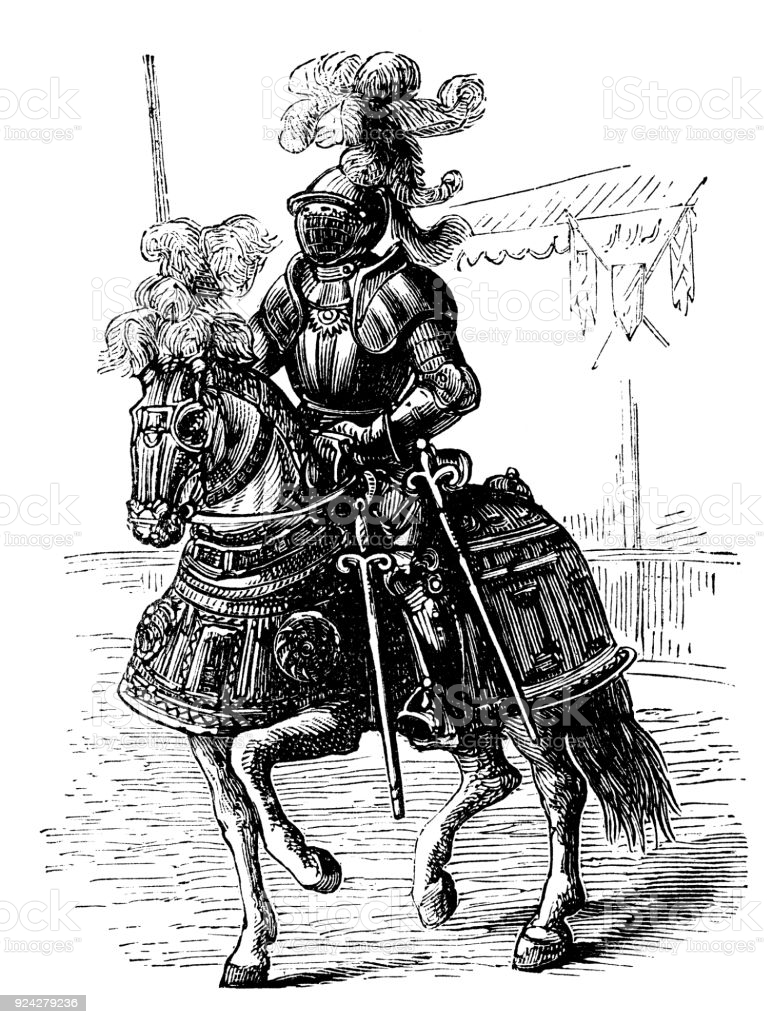SRD //HOME
Knight
| Knight Level Progression | |||||||||
|---|---|---|---|---|---|---|---|---|---|
| level | XP | Title | HD | THAC0 | D | W | P | B | S |
| 1 | 0 | Squire | 1d8 | 19[0] | 12 | 13 | 14 | 15 | 16 |
| 2 | 2,500 | Squire | +1d8 | 19[0] | 12 | 13 | 14 | 15 | 16 |
| 3 | 5,000 | Rider | +1d8 | 19[0] | 12 | 13 | 14 | 15 | 16 |
| 4 | 10,000 | Lancer | +1d8 | 17[+2] | 10 | 11 | 12 | 13 | 14 |
| 5 | 18,500 | Armiger | +1d8 | 17[+2] | 10 | 11 | 12 | 13 | 14 |
| 6 | 37,000 | Scutifer | +1d8 | 17[+2] | 10 | 11 | 12 | 13 | 14 |
| 7 | 85,000 | Esquire | +1d8 | 14[+5] | 8 | 9 | 10 | 10 | 12 |
| 8 | 140,000 | Knight Errant | +1d8 | 14[+5] | 8 | 9 | 10 | 10 | 12 |
| 9 | 270,000 | Knight Bachelor | +1d8 | 14[+5] | 8 | 9 | 10 | 10 | 12 |
| 10 | 400,000 | Knight | +2 | 12[+7] | 6 | 7 | 8 | 8 | 10 |
| 11 | 530,000 | Knightly Lord, 11th | +2 | 12[+7] | 6 | 7 | 8 | 8 | 10 |
| 12 | 660,000 | Knightly Lord, 12th | +2 | 12[+7] | 6 | 7 | 8 | 8 | 10 |
| 13 | 790,000 | Knightly Lord, 13th | +2 | 10[+9] | 4 | 5 | 6 | 5 | 8 |
| 14 | 920,000 | Knightly Lord, 14th | +2 | 10[+9] | 4 | 5 | 6 | 5 | 8 |
Knights are warriors who serve a noble house or knightly order, carrying out their liege’s command and upholding the honour of the liege at all costs. They are masters of heavily armoured, mounted combat, preferring the lance above all other weapons. Knights are often members of the noble classes, but a person of lowlier origin may be initiated as a knight as a reward for noble deeds.
Knighthood: Knights of 1st and 2nd level are known as “squires” and are not yet regarded as true knights. Upon reaching 3rd level, the character is knighted by their liege and gains the right to bear a coat of arms (typically emblazoned upon the knight’s shield).
Alignment: A knight must have the same alignment as their liege.
Chivalric Code
Knights are bound by a stringent code of honour, which they strive to uphold in all their deeds. A knight does not earn any experience points for deeds performed at odds with this code. The fundamentals of this code are:
- Preference of death over dishonour
- Service of the knight’s liege as the greatest honour
- Glory in single combat
- Defence to the death of any in the knight’s charge
- Honouring of superiors
- Respect of equals
- Demanding obedience from inferiors
- Scorning the ignoble
Dishonour: A knight who brings dishonour upon themselves or their liege (this may include changing alignment) may have their knighthood revoked. In this case, the character becomes a fighter of equivalent level. It may be possible to regain the status of knighthood by performing a special quest.
Combat
Knights can use all melee weapons but cannot use missile weapons (they regard these as dishonourable). They can wear any metal armour but scorn non-metal armour as only suitable for peasants and villains.
Prowess of arms: Knights regard armour as a symbol of prowess and status, always favouring the most impressive and impervious- looking armour available.
Single combat: In a battle, a knight must attack the most powerful or worthy foe in single combat.
Flying Mounts
A knight of 5th level or higher can train fantastic, flying monsters as mounts. This takes one month. In general, a knight may train flying monsters of Hit Dice at most equal to the knight’s level. The use and training of flying monsters as mounts is at the referee’s discretion.
Horsemanship
Assessing steeds: Knights are expert riders and can assess the worth of any steed. This allows a knight to determine whether an animal has low, average, or high hit points for its type.
Urging great speed: From 5th level, a knight can urge their steed to great speed, increasing its movement rate by 30’ (10’) for up to 6 turns, once per day.
Hospitality
A knight of 3rd level or higher can expect hospitality and aid from nobles and other knights of the same alignment or social affiliation (e.g. order, religion, noble house, etc.). A knight is expected to extend such hospitality in kind.
Mounted Combat
Knights gain a +1 bonus to attack rolls when mounted.
Strength of Will
Fear: Knights are immune to all supernatural fear effects. From 3rd level, companions within 10’ of the knight gain a +2 bonus on saving throws against fear effects, and retainers and mercenaries under the knight’s command within 10’ gain a +2 bonus to loyalty or morale.
Beguilement: Knights gain a +4 bonus to saving throws against hold spells, charms, mind control, hypnotism, suggestion, etc. They gain a +2 bonus to saving throws against illusion, and gain a saving throw (one is not normally allowed) against sleep spells.
Stronghold
Any time a knight of 3rd level or higher wishes (and has sufficient money), they can build a castle or stronghold and control the surrounding lands. The permission of the knight’s liege is always required.
After Reaching 9th Level
A knight may be granted a title such as Baron or Baroness. The land under the knight’s control is then known as a Barony.
